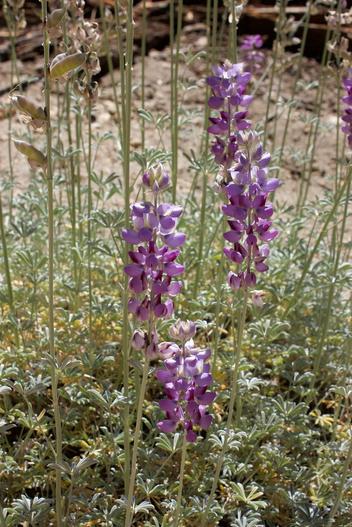Mountain Bush Lupine
(Lupinus excubitus var. austromontanus)
Mountain Bush Lupine (Lupinus excubitus var. austromontanus)
/
/

Laura Camp
CC BY-SA 2.0
Image By:
Laura Camp
Recorded By:
Copyright:
CC BY-SA 2.0
Copyright Notice:
Photo by: Laura Camp | License Type: CC BY-SA 2.0 | License URL: https://creativecommons.org/licenses/by-sa/2.0/ | Uploader: campsjc | Publisher: Flickr









Estimated Native Range
Summary
Lupinus excubitus var. austromontanus, commonly known as Mountain Bush Lupine, Mountain Grape Soda Lupine, or Mountain Lupine, is a perennial shrub native to chaparral, mountainous regions, and desert slopes of California. It exhibits a moderate growth rate and typically reaches a height of 1-3 feet (0.3-0.9 meters) with a similar spread of 1-2 feet (0.3-0.6 meters). This lupine variety is characterized by its palmately compound leaves and dense clusters of blue or white flowers that are quite showy, blooming profusely in the spring and early summer. The plant’s appearance is further enhanced by its silvery-green foliage.
Mountain Bush Lupine is valued for its drought tolerance and ability to thrive in poor soils, making it an excellent choice for xeriscaping and native plant gardens. It is also used for habitat restoration projects as it enriches the soil with nitrogen, a benefit of being a member of the legume family. In cultivation, it requires full sun exposure and well-draining loam or sandy soils. It is relatively low maintenance, needing minimal supplemental water once established. While generally disease-free, it can be susceptible to root rot if overwatered or planted in poorly draining soils. Gardeners should be aware that all parts of the plant are toxic if ingested.CC BY-SA 4.0
Mountain Bush Lupine is valued for its drought tolerance and ability to thrive in poor soils, making it an excellent choice for xeriscaping and native plant gardens. It is also used for habitat restoration projects as it enriches the soil with nitrogen, a benefit of being a member of the legume family. In cultivation, it requires full sun exposure and well-draining loam or sandy soils. It is relatively low maintenance, needing minimal supplemental water once established. While generally disease-free, it can be susceptible to root rot if overwatered or planted in poorly draining soils. Gardeners should be aware that all parts of the plant are toxic if ingested.CC BY-SA 4.0
Plant Description
- Plant Type: Shrub
- Height: 1-3 feet
- Width: 1-2 feet
- Growth Rate: Moderate
- Flower Color: Purple, White, Yellow
- Flowering Season: Spring, Summer
- Leaf Retention: Deciduous
Growth Requirements
- Sun: Full Sun
- Water: Low
- Drainage: Fast
Common Uses
Butterfly Garden, Deer Resistant, Drought Tolerant, Low Maintenance, Showy Flowers
Natural Habitat
native to chaparral, mountainous regions, and desert slopes of California
Other Names
Common Names: Mountain Grape Soda Lupine, Mountain Lupine
Scientific Names: , Lupinus excubitus var. austromontanus, Lupinus albifrons var. austromontanus, Lupinus austromontanus, Lupinus excubitus subsp. austromontanus,
GBIF Accepted Name: